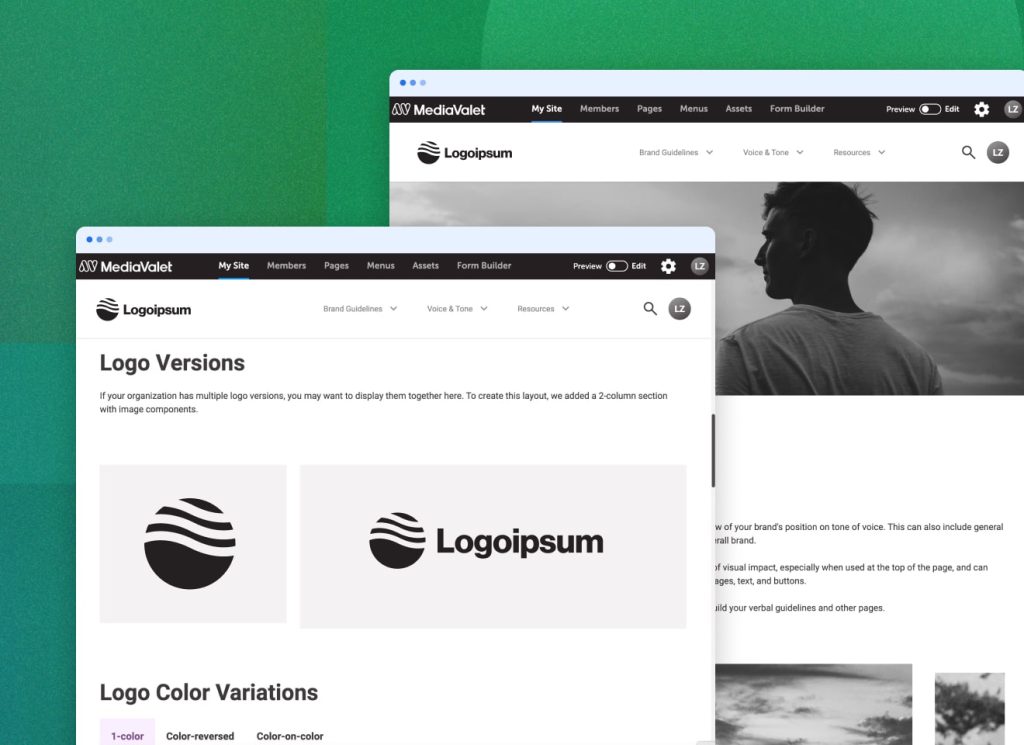← DAM Dictionary
Brand Governance
What is Brand Governance?
Maintaining a consistent brand in a world of distributed teams, global campaigns, and endless digital touchpoints is no small feat. That’s where brand governance comes in.
Brand governance gives organizations the structure they need to safeguard their identity, ensure quality, and enable scale—all while empowering teams to move faster, not slower.
In this comprehensive guide, we’ll break down what brand governance is, why it’s critical for modern organizations, how to implement it successfully, and what tools and templates can help.
Brand Governance Definition
At its core, brand governance refers to the systems, policies, tools, and teams that ensure your brand is consistently and correctly represented—across all channels, geographies, and use cases.
It’s not just about logos and color palettes. It’s about how your brand shows up in the world—visually, verbally, and experientially—and ensuring everyone who touches it does so in a way that aligns with your values and strategy.
Why It’s Gaining Momentum
With more teams working remotely and more content being created across departments, the risk of inconsistency has skyrocketed. A brand governance model serves as the “north star” for everyone—from marketing and sales to HR and external partners.
Why Brand Governance Matters More Than Ever
Consistent branding is more than a nice-to-have—it’s a revenue driver and trust builder.
Business Impact
- Brands that present consistently across platforms increase revenue by up to 33%
(Lucidpress). - Clear brand usage guidelines reduce approval timelines and cut down on content rewrites.
- Fewer compliance issues = reduced legal risk and reputational damage.
Organizational Efficiency
- Teams spend less time asking for logos, messaging, and asset permissions.
- Onboarding new employees or agencies becomes faster and more effective.
- Reuse and repurposing of brand-approved content increases—amplifying ROI.
Iron Fist vs Lean Governance: Finding the Right Approach
Brand governance doesn’t look the same for every organization. The best approach depends on your industry, risk tolerance, and culture.
| Governance Style | Description | Best For |
|---|---|---|
| Iron Fist | Centralized control, strict approvals, limited flexibility. All content is reviewed before release. | Regulated industries (e.g., healthcare, finance, legal) |
| Lean Governance | Decentralized with flexible use of templates, clear guidelines, and trusted autonomy. | Creative industries, startups, marketing-led teams |
Most organizations now aim for a hybrid approach—strong brand guardrails combined with self-service tools and training.
The Core Components of an Effective Brand Governance Framework
To build a resilient brand governance strategy, you need a mix of people, process, and technology. Here’s what that looks like:
1. Brand Guidelines That Go Beyond the Basics
Modern guidelines are no longer static PDFs. They’re interactive, dynamic, and include:
- Visual identity (logos, colors, typography)
- Messaging frameworks and tone of voice
- Use cases and “do/don’t” examples
- Templates for documents, ads, and social content
Learn more about how MediaValet’s Experience Portals are enabling living, breathing, interactive brand guidelines.

2. A Centralized Digital Asset Management (DAM) System
A DAM ensures that everyone—from designers to global resellers—has access to the most current, approved brand assets.
Benefits of DAM:
- AI-powered metadata tagging and search
- Version control and auto-expiry of outdated assets
- Role-based permissions for internal and external users
Tools to consider: MediaValet, Canto, Bynder (See more on these below)
Learn more about What Digital Asset Management is here.
3. Clearly Defined Roles and Responsibilities
Who is responsible for brand integrity? It depends on your org structure, but common roles include:
- Brand Managers: Own and maintain brand guidelines
- Marketing Ops: Manage tool access, DAM permissions, workflows
- Creative Leads: Review and approve visual content
- Regional Teams or Partners: Use brand materials in market-specific campaigns
Pro Tip: Use a responsibility matrix (RACI) to avoid confusion and ensure accountability.
4. Approval Workflows and Escalation Paths
Efficient approval processes are essential—especially when creative output is high. Define:
- What types of assets need review
- Who needs to approve what
- When exceptions are allowed
- Time limits or automation rules
5. Training, Onboarding, and Ongoing Support
Create structured onboarding for:
- New employees
- Contractors and freelancers
- Channel partners and agencies
Resources might include:
- Video walkthroughs
- Interactive brand hubs
- Intranet playbooks
- “Office hours” with brand team members
Pro Tip: Update your branding guidelines regularly—brands evolve.
6. Monitoring, Reporting, and Brand Health Audits
To ensure governance sticks:
- Use DAM analytics to track asset usage and downloads
- Audit public channels for compliance (web, social, email)
- Schedule regular governance reviews (quarterly or semi-annually)
Use AI or automation to flag outdated assets, unauthorized usage, or off-brand language.
Top Tools That Support Brand Governance
| Platform | Strengths | Ideal For |
|---|---|---|
| MediaValet | DAM, Experience Portals, proofing, automation, AI tagging | Enterprise-level brand teams |
| Canto | Easy-to-use DAM, version control, integrations with productivity tools | Small to mid-sized teams getting started with governance |
| Bynder | Content collaboration and templating | Multi-brand organizations |
Brand Governance Checklist
Use this quick checklist to assess your brand governance maturity:
| ✅ | Question |
|---|---|
| ☐ | Do we have up-to-date and accessible brand guidelines? |
| ☐ | Is our DAM system in active use with the latest assets? |
| ☐ | Do our teams understand who approves what—and when? |
| ☐ | Are we training new team members and partners on brand use? |
| ☐ | Do we audit our brand presence regularly? |
| ☐ | Can we measure asset usage and compliance in real time? |
Create Confidence Through Consistency
Strong brands don’t happen by accident—they’re designed, nurtured, and governed. Brand governance is the key to enabling scalable creativity without sacrificing consistency or trust.
It’s not about controlling every move. It’s about empowering your teams with the tools and frameworks to create confidently and stay aligned with your brand vision.